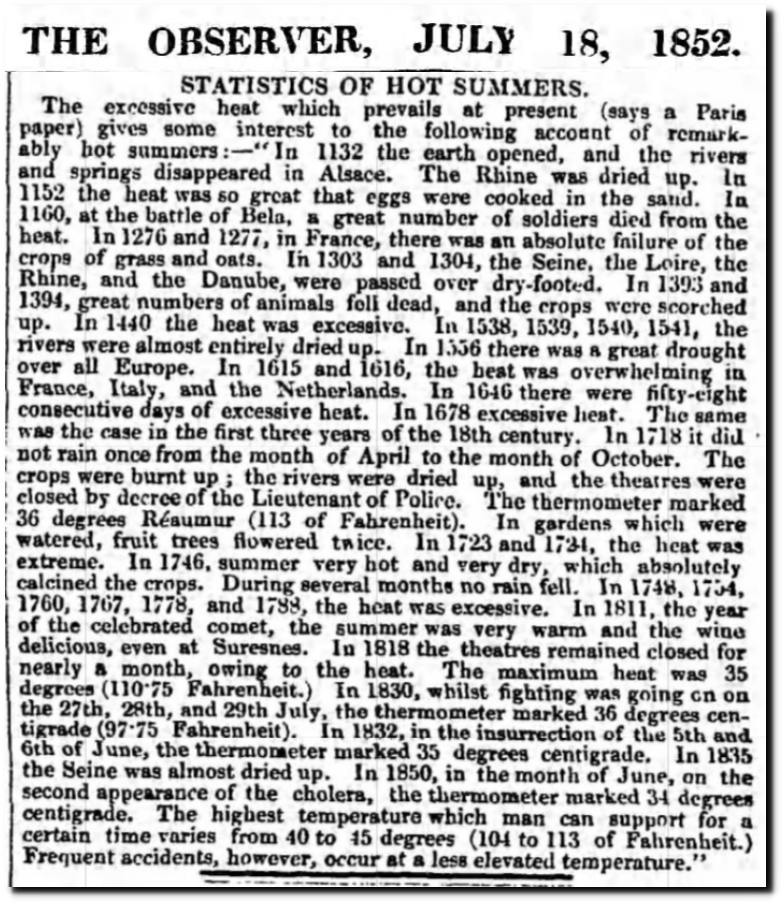“STATISTICS OF HOT SUMMERS.
The excessive heat which prevail. at present (says a Paris paper) gives some interest to the following account of remarkably bot summers :—” In 1132 the earth opened, and the rivers and spring; disappeared in Alsace. The Rhine was dried up. In 1152 the heat was to great that eggs were cooked in the sand. In 1160, at the battle of Bela, a great number of soldiers died from the heat. In 1276 and 1277, in France, there was an absolute failure of the crops of grass and oats. In 1303 and 1304, the Seine, the Loire, the Rhine, and the Danube, were passed over dry-footed. In 1393 and 1394, great numbers of animals fell dead, and the crops were scorched up. In 1440 the heat was excessive. In 1538, 1539, 1540, 1541, the rivers were almost entirely dried up. In 1556 there was a great drought over all Europe. In 1615 and 1616, the heat was overwhelming in France, Italy, and the Netherlands. In 1646 there were fifty-eight consecutive days of excessive heat. In 1678 excessive heat. The same was the case in the first three years of the 18th century. In 1718 it did not rain once from the month of April to the month of October. The crops were burnt up ; the riven were dried up, and the theatres were closed by decree of the Lieutenant of Police. The thermometer marked 36 degrees Reaumur (113 of Fahrenheit). In gardens which were watered, fruit trees flowered twice. In 1723 and 1724, the heat was extreme. In 1746. summer very hot and very dry, which absolutely calcined the crops. During several months no rain fell. In 1748, 1754, 1760, 1767, 1778, and 1749, the heat was excessive. In 1811, the year of the celebrated comet, the summer was very warm and the wine delicious, men at Semmes. In 1818 the theatres contained closed for nearly a month, owing to the heat. The maximum heat was 35 degrees (110.75 Fahrenheit.) In 1830, whilst fighting was fining on on the 27th. 28th, and 29th July, the thermometer marked 36 degrees centigrade (97.75 Fahrenheit). In 1832, in the insurrection of the 5th and 6th of June, the thermometer marked 35 degrees centigrade. In 1695 the Seine was almost dried up. In 1850, in the month of June, on the second appearance of the cholera, the thermometer marked 34 degrees centigrade. The highest temperature which man can support for a certain time varies from 40 to 45 degrees (104 to 113 of Fahrenheit.) Frequent accidents, however, occur at a less elevated temperature.”
18 Jul 1852, 7 – The Observer at Newspapers.com
“Summer Heat Precedents.
A German writer, dealing with certain prognostications (usually heard at this time of the year) of great summer heat, goes back for precedents. In 637, he says, the springs were dried up and men fainted with the heat. In 879 II was impossible to work in the open fields. In the year 993 the nuts on the trees were roasted, as if in a baker’s oven. In 1000 the rivers in France dried up, and the stench from the dead fish and other matter brought a pestilence into the land. The heat in the year 1014 dried up the rivers and the brooks In Alsace-Lorraine. The Rhine was dried lap in the year 1132. In he year 1152 the heat was eo great that eggs could be cooked in the sand. In 1227 it is re. corded that many men and animals came to their death through the intense heat. In the year 1303 the waters of the Rhine and the Danube were partially dried upend the people passed over on foot. The crops were burned no in the : year 1394, and in 1538 the Seine and Loire were as dry land. In 1556 a great drought swept through Europe. In 1614 in France, and even in Switzerland, the brooks and the ditches were dried up. Not less hot were the years 1048. 1779 and 1701. In the year 1715 • from the month of March till October not a drop of rain fell, the temperature arose to 38 degrees Reamer and in favored places the fruit trees blossomed a second time. Extraordinarily hot were the year. 1724, 1746, 1756 and 1811. The summer of 1815 was so hot -the thermometer standing at 40 degrees Reaumur -that the places of amusement had to he closed.—London Daily News.



